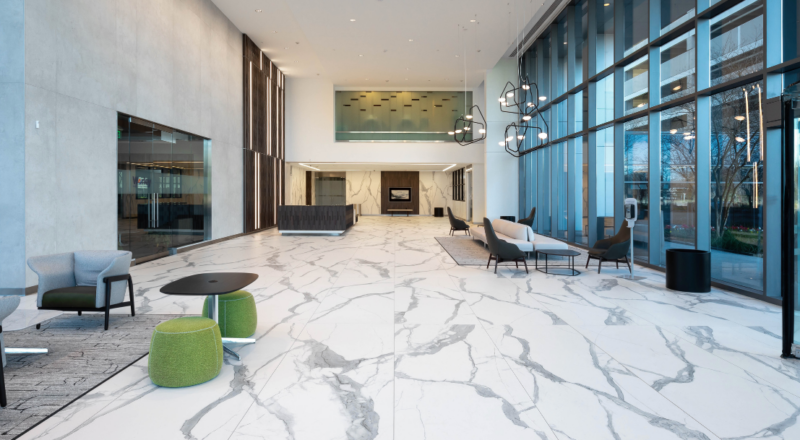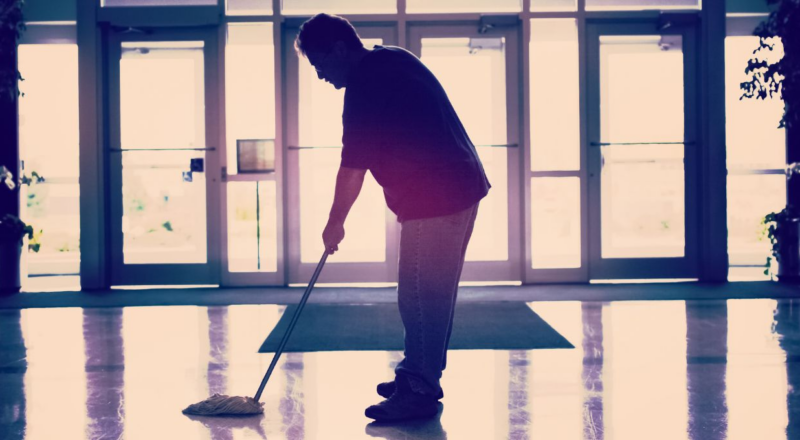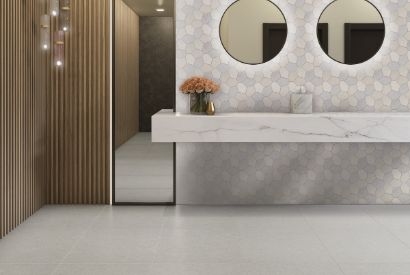Exciting news about forthcoming updates to building facade codes was recently announced by the Tile Council of North America. This update is particularly relevant to Crossville’s gauged porcelain tile panels. The International Building Code (IBC) will be changing the size allowance for adhered porcelain tiles for building facades with the release of the 2021 IBC.
According to the press release from the TCNA, “An update to the International Building Code (IBC) will allow designers to use adhered porcelain tiles as large as 48 x 48 inches or 36 x 72 inches on building facades. The proposed change, driven by the International Masonry Institute (IMI) and the Tile Council of North America (TCNA), was certified by the International Code Council Board of Directors this month and will go into effect in the 2021 IBC.”
Crossville’s Director of Technical Services Noah Chitty explains further that “this change allows for larger tile panels to be installed as building facades with just thin set and movement joints based on weight per square foot.” The creative possibilities and installation opportunities with this code change are tremendous. For example, Crossville’s gauged porcelain tile panels that are 3 mmm thick weigh only 1.7 pounds per square foot and with the new code that is a half panel of our 1 m x 3 m size which covers 16 square feet providing great coverage and an efficient use of product with very little waste.
Additionally, the TCNA explained, “Advances in porcelain tile manufacturing have resulted in extremely large and extremely thin tiles, as thin as 1/8 inch, now being widely available. Moreover, tile setting mortar is now more resistant to tensile and shear forces, thanks to advances in polymer- modified Portland cement mortar technology. The combination of these factors – thinner, lighter tiles and stronger mortars – already allow larger tiles to be successfully adhered to exterior facades.”
Chitty elaborated that many times project managers, specifiers, designers and installers were working with individual building code inspectors for variances based on specific products. Now, it should be much easier without having to seek variances for individual projects as the building code covers the specifics for large format tile.
With the ability to skin a variety of surfaces, Crossville’s porcelain tile panels offer many unique benefits that make them an ideal specification for building facades. With outer dimensions of 1m x 3m, these generously proportioned panels install efficiently with minimal joints, helping to achieve a sleek, uninterrupted look. Another major advantage of using the Crossville tile panels is the weight compared to other cladding options — light enough in weight to be handled by fewer workers. Available in a large variety of colors and styles, the tile panels answer the aesthetic demands and are actually more consistent in appearance than other materials such as natural stone.
Crossville’s gauged porcelain tile panels are not a beautiful appearance for the building, but they are also able to withstand harsh weather environments. They’re innately resistant to UV rays and are highly scratch-proof and resistant to deep abrasion. Also, the panels are eco-friendly, as the body of the tiles is comprised of natural raw materials, and the tile does not release toxins into the environment.
Revisit Crossville’s gauged porcelain tile panels as you think ahead for your 2021 projects by clicking here.
Video Transcript
Tile Tech Talk with Noah Chitty
Irene (00:00): Hey Noah, thank you for carving some time. So good to see you. Everybody’s safe at home, I suppose?
Noah (00:15): Yes, we’re all here and safe.
Irene (00:17):..and yet working. We’re doing Virtually Crossville. We’re bringing some really good information to folks that they would have perhaps gotten at the trade shows, but now we’re bringing it online. And there are some really important topics that are at the forefront for the tile industry, and you are our guru. But I don’t, use that term lightly—you’ve earned “guru.”
So first things first, I know there is a new building code update that, and I’m reading here, that designers have more flexibility to use large exterior adhered porcelain tile. This sounds really cool. So please talk us through what that really means.
Noah (01:00): So the conversation started probably three or four years ago. So what happened in the tile industry was I think in 2010, there became language in the building code that singled out porcelain tile as an adhered veneer and put a size limitation to it. Prior to that, we were included, I think in what was considered exterior adhered masonry veneer. And it gave us a size of about 5 square feet with no side over 36 inches. When the code changed, for this, for whatever reason, it limited us to 3 square feet with no side over 24 inches, and this was prior to porcelain tile panels, too. So the code cycle only happens once every three years for the code to actually change. So, if you want to affect upcoming code cycle, you’ve really got to start three or four years to kind of get your ducks in a row. So we started talking about this and we said, you know, it’d be nice if we could address panels and it’d be nice if we could address, you know, what seems to be outdated size limitations based on, you know, how good setting materials have gotten and what innovation is.
So what you have to do is you have to go to a code hearing and you have to make your case for a change in language. But it’s a pretty time consuming process because you actually have to come up with alternatives if they don’t like your first submission and there’s hundreds and hundreds of submissions. So I actually went to support Tile Council in the effort. So that the effort was led by Tile Council and the International Masonry Institute—IMI. But a few of us went also… Jim from Mapei and myself, to just kind of support. Jim actually talked. But you’re waiting; we waited a day and a half for our five minutes to speak, and you have to be really concise and that kind of thing.
Irene: Where were you? Was that in DC?
Noah: That was an Albuquerque. I think it moves, the code hearings move from place to place cause, I don’t remember, October was somewhere else. Las Vegas, I think when we were at Total Solutions.
So, the steps in the process are you go to the main meeting in Albuquerque, you present your case, you present your language. And then after that you see what votes you got. And we actually got, I think there were 12 members on the committee, 12 or 14, and we got a unanimous yes at the committee. So that was the first time that we were going to be okay. But then you have to go through a long public comment period, and if you get public comments against your submission, then you have to address those. So that period actually ended when we were at Total Solutions. And we didn’t get any public comments so it went past that. So, it was actually just in the last week or two where it was final confirmation of the change to the building code.
So it’ll go into the 2021 general building code and it’ll change two things really was our submission. One was, there was a chart that said, what is the minimum thickness of tile that’s direct bonded to the outside of a building, and it was listed at a quarter inch, but because of panels, we really wanted to see that at an eighth of an inch because we have the thinnest 3 millimeter panels. So that change went through and then a change on the tile size itself.
So we changed the minimum thickness thing and we changed the size limitation for the tile. So what it gave us was we separated tile between things that were under 3 ½ pounds per square foot cause we figured that was the maximum weight of a panel. And then over 3 ½ pounds per square foot. So for thicker traditional tiles, which are about 5 pounds per square foot, we got the change from 3 square feet with no side over 24 inches to 9 square feet with no side over 48 inches. So it would now allow a 24 by 48 or even a little bit bigger to be direct bonding to the outside of the building. Because all of this is without mechanical fastening. How big of a piece of tile you have to stick on the side of a building with just thin set and movement joints and be adhered. So we got from three square feet to nine square feet for regular tile. And then panels weren’t really addressed at all. So for things under 3 ½ pounds per square foot because they weigh much less, like our 3 millimeter panel only weighs 1.7 pounds per square foot. We actually got that size changed to 17 ½ square feet. So for us it’s a half panel of our 1 meter by 3 meter, which comes out at like 16 something square foot.
So we can very easily use a modular size out of our panel to maximize what we can do with very little waste. Then we looked at larger panels and you know, might be a third of a 5 by 10 or a quarter of something bigger, something like that.
Irene: In practical application, pun intended, what does this mean for folks?
Noah: So it means two things. So the complicated thing really is IBC, the International Building Code, changes in 2021, this language will become there, but every single municipality/state/whatever then adopts. So there’s a California building code or Florida building code or North Carolina. And what they do is they take either the building code as a whole and adopt all or the parts that are applicable to them, or they might add a little bit. Like in California, they might need to add some seismic and in Florida they might need to have some hurricane related information. So it’ll still be a while before we see that language go into local municipalities and state building codes.
But in the interim, what we can do is when we go to select, right now, let’s say the Oklahoma building code still says the biggest tile we can put in is three square feet on the side of a building. Before what we would have done is go to the building official and say, ‘Hey, we’d like to submit an alternate and we’d like you to allow this larger size tile because this talked about big heavy things not being okay on the side, but we have these lighter weight products. So could you allow a larger size?’ So that was an argument you were making one off, you know, case by case basis to each individual building inspector and you know, may or may not be successful with that.
Now we could actually produce a piece of paper that says, ‘Hey, you know, this isn’t just our opinion about the building code being too limited. The building code’s actually changing and because there are three year code cycles that were changed into this,’ that should in my mind at least make a building official feel more comfortable that they’re adopting something that’s not necessarily just your opinion but is something the code is actually evolving to include.
So it should allow us cause for me it was ridiculous. We couldn’t put a 6 by 36 on the outside of a one story building without these complications. So I think it’s a really big deal for the tile industry, you know, especially as we are losing some of the square footage and spaces that we’ve traditionally been, if we can capitalize on spaces where we could be, where it’s harder for alternative products to play in that space, I think it could be a win for us.
(09:33): So for sure the change and then how we capitalize on it as an industry and as a company. You know, it’s up to us.
Irene: So we’re thinking ahead to 2021 on this.
Noah: Yeah, yeah. 2021 we’ll have the book with the language in it. Right now we’ve just kind of written up the language. So if we got to approach a code official tomorrow, you know exactly how it changed and that kind of thing so they can put that.
Irene: So it can be in the spec for something that’s going to be built in 2021
Noah: Until 2021 and maybe even longer. Because I think there’s some municipalities out there probably still using 2015 building code even though the 2018 would have been the last full cycle change. So you know, in some states or places it might be a long time before their building code actually says this new language, but actually having the 2021 change so there’s language in a book and even now having the documentation of the final approvals of that language will help us have that conversation easier even in the interim until the language is adopted into IBC. And then as it goes down the chain.
Irene: And what an interesting little insight into how building codes even happen.
Noah: It was, you know, a first for me. It was really interesting. The whole process of it. So there were code consultants and there was a clock, you only got to speak for two minutes and when you were done you were done. And it was a little nerve wracking. I was really happy that I didn’t have to speak. I mean I was ready, but I was nervous to get up there and just not make a mistake and say the wrong thing.
Irene (11:23): That teaches you to be concise
Noah: It taught me how things work. Right. I mean, how does a bill become a law? I mean, how does language get into building code? How do you change it? So for me it was this really interesting process of how the kind of inner workings of our industry do, and we haven’t as an industry paid enough attention in years past to building code and how it affects us. So I think this process may at least shine the light on a little bit how we should be paying attention. You know, cause sometimes it’s just things change if you’re not there, if you’re not affecting your own destiny.
Irene (12:06): And look at how our product is evolving. This is so, in my opinion, really necessary. And in my years in the industry, it’s kind of cool to see us using tile in more creative ways and more opportunities for all of us.





